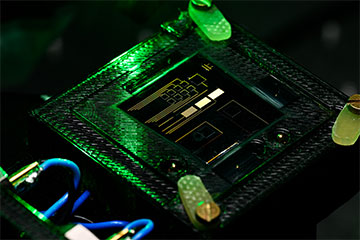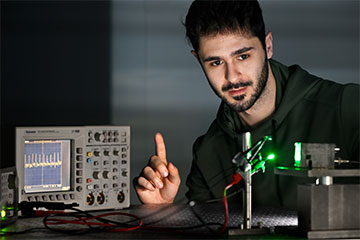
A new thin-film photodetector could help measure patients’ heart rate and other vital signs at some distance from the body, thanks to additional green light boosting the detector’s quantum efficiency. [Image: TU/e | B. van Overbeeke]
The ability to monitor heart rate and other vital signs from a distance provides a number of benefits to patients, including better hygiene and more comfort. Optical techniques are in principle ideally suited to this task but previously required bulky components to distinguish weak signals from background noise.
Now researchers in the Netherlands have developed a tandem thin-film photodetector that can pick out a person’s heart and respiration rate from over a meter away (Sci. Adv., doi: 10.1126/sciadv.adf9861). The device is inherently narrowband and has a very high quantum efficiency—more than 200%—when illuminated by near infrared (NIR) and green light together.
Monitoring at a distance
The medical technique known as photoplethysmography involves shining green, red or NIR light on a patient’s innermost layer of skin and measuring either the transmitted or reflected light with a photodetector. The recorded light intensity variations correspond to fluctuations in the volume of blood passing through that person’s arteries, which in turn reveal information such as heart rate, variability of heart rate and oxygen saturation in the blood.
To carry out such monitoring at distance requires picking out fairly weak, lossy signals from random fluctuations in ambient light. This can be done using commercial infrared cameras, but such devices require expensive, bulky optics to perform the task—which is a problem when trying to integrate the equipment in a hospital setting—and can also potentially infringe on a patient’s privacy.
Another option is solution-processed thin-film photodiodes. In particular, devices made from organic molecules or perovskite crystals are quick and sensitive and have tuneable bandgaps, meaning they can be tailored for narrow or broadband detection. Currently, however, the kind of narrowband configurations that would be best suited to screening out background noise are quite inefficient, particularly at the NIR wavelengths that are fit for human usage.
Adding green to red
In the latest research, Riccardo Ollearo, René Janssen and colleagues at Eindhoven University of Technology, together with researchers at the Holst Centre in Eindhoven, overcome this problem by fabricating a photodiode akin to a tandem solar cell. The device features a layer of wider-bandgap perovskite under a narrower-bandgap organic layer, with the two separated by a thin organic interlayer and sandwiched between a pair of electrodes.
The perovskite layer absorbs almost all the shorter-wavelength photons, leaving the organic layer to mop up the longer wavelength light. The interlayer prevents electrons generated by the perovskite from reaching the cathode, so the current at the output is due to a narrow range of wavelengths around that of the signal—in the near infrared.

Using the photodiode device held 130 cm away from his finger, Riccardo Ollearo was able to detect minute changes in the amount of infrared light that was reflected back into the diode. These changes turn out to be a correct indication of a person’s heart rate. [Image: TU/e | B. van Overbeeke]
The researchers tried out a variety of combinations of perovskite and organic materials, finding that what are known as FAMAPbI3 and PM6:Y6 provide the narrowest, most pronounced peak at the desired wavelength (850 nm). They also showed that the photodiode’s performance remained consistent when exposed to a continuous stream of light pulses arriving once every second for 8 hours—as it might be if monitoring the heartbeat of someone sleeping.
More strikingly, they also found that by exposing the device to an additional source of green light (at 540 nm), they could boost the quantum efficiency enormously—reaching a whopping 220% for green light with an intensity of 60 mW/cm2. The researchers speculate that electrons generated in the perovskite layer by the green light initially accumulate behind the interlayer, and that NIR radiation absorbed by the organic layer lowers the energy barrier keeping these particles hemmed in. The combination of the electrons thus liberated, as well as the charge carriers generated by the NIR radiation itself, leads to a larger current in response to a given flux of NIR photons.
Measuring heart and breathing rate
To exploit this effect to measure heartbeats, Ollearo and colleagues positioned an NIR light-emitting diode just above a person’s finger while placing an optical filter, green LED and their photodetector just below. They recorded a waveform with a rate of 67 beats per minute, complete with the systolic and diastolic features that characterize variations in blood pressure due to pumping by the heart. Together, the two LEDs consumed a mere 0.2 mW—some two orders of magnitude less than would be required from a single NIR LED producing a similar output (given the latter’s disproportionate consumption at higher intensities).
The researchers then showed how their photodetector could be operated remotely, using it to track both the heartbeat and breathing rate of a 29-year-old volunteer. By reflecting NIR light from the person’s hand around 50, 90 and 130 cm away, they observed in each case the systolic and diastolic phase of the heartbeat (although power consumption was several tens of milliwatts in this instance). To measure respiration, they instead bounced the radiation off the volunteer’s chest, revealing a variation of around 14 cycles per minute—typical of a healthy adult’s respiration while at rest.
Ollearo and co-workers found that their thin-film photodetector screened ambient noise better than a commercial broadband silicon photodetector, generating a signal more than twice as strong even when the latter was equipped with an 830-nm filter. Pointing out that their device could be quite cheaply manufactured using large-area processing, they conclude that the new instrument is well-suited for “the next generation of contactless vital-sign monitoring devices.”
The researchers found they did not need to accurately align the NIR LED and photodetector to measure either the heart or breathing signals, making it easier to integrate the components into a patient’s surroundings. Ollearo acknowledges that movement of a patient’s finger while being monitored could alter the readings, but he says that other groups at Eindhoven University of Technology are working on algorithms to track and correct for such movements. He adds that placing multiple sensors elsewhere on the body might further reduce the problem.
Future plans
As to next steps, the researchers hope to reduce the response time of their device from its current microsecond level by changing the geometry—in particular the size—of individual photodiodes. They would also like to clinically test their device, perhaps by collaborating with other researchers in Eindhoven who are developing a new kind of camera to monitor heart and breathing rates.
